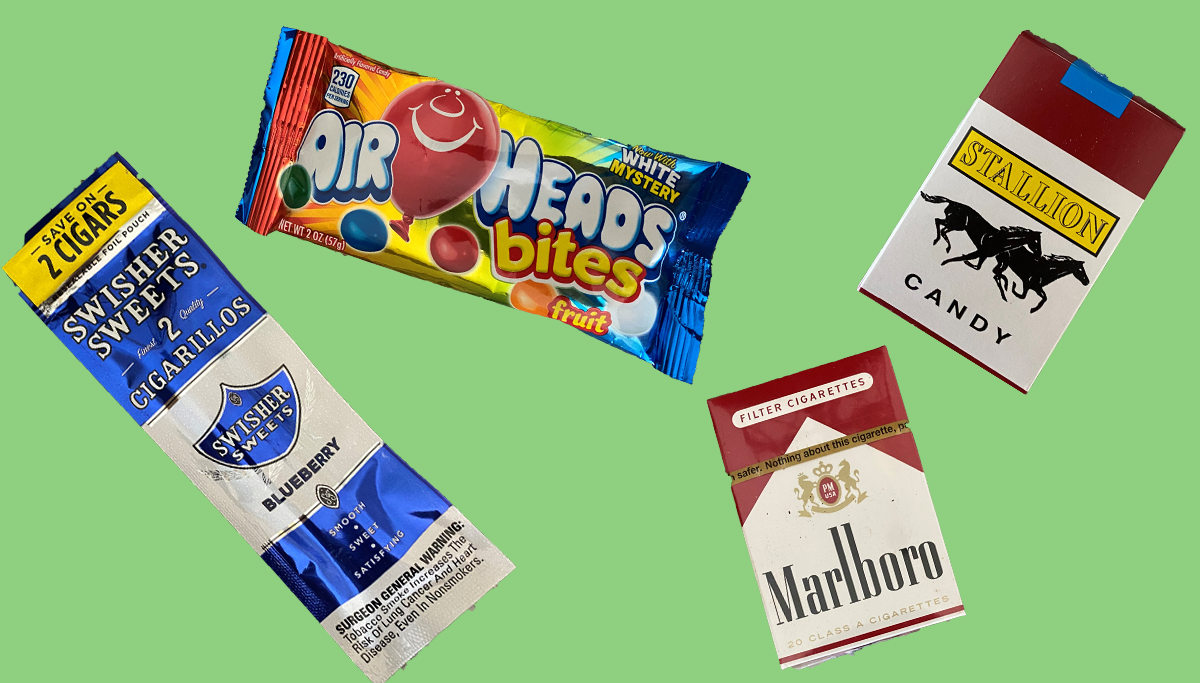Don’t be fooled by the fun packaging for either one. Both tobacco and candy are bad for your oral health. But why does packaging for tobacco products and candy products look so much alike on the shelf?
Studies note that the tobacco industry has updated their look to mirror the fresh, bright feel of sugary sweets packaging. Why? To increase the appeal for young adults. Does it work? The most recent Youth Risk Behavior Survey from the SD Dept. of Health shows that nearly HALF of high school seniors have used some form of tobacco in the last 30 days.
The similarities between candy and tobacco packaging don’t end there. So, what’s going on with package marketing?
In 2018, food companies spent “$20.7 million to advertise children’s drinks with added sugars, primarily targeting kids under age 12.” That’s not soda, but fruit drinks, flavored waters, and drink mixes. Though it isn’t fair to consider all juices as candy, it is important to note that kids are getting hooked on candy-like sugary drinks.
However, that marketing spend is a drop in the bucket compared to the $9.1 billion tobacco companies spent in the same year. $8.7 billion of that was spent on point-of-sale promotions that have been found to attract youth smokers.
Looking at the packaging, we can see similarities of the fresh, bright feel of sugary candy and sweetened drinks and tobacco product packaging. It sends an enticing signal to kids and adults that minimizes the harm to oral and overall health.
And it goes beyond the packaging. Vaping products now come in hundreds of sweet flavors like cotton candy and gummy bear that are just as bad for oral health as the actual candy.
Why it’s important to avoid tobacco and sugar
Tobacco use is terrible for your whole body, including your oral health. Using tobacco can lead to:
- Oral cancer
- Periodontal disease.
- Salivary gland inflammation; and
- Stained teeth and bad breath
Whether inhaled or smokeless, tobacco impacts the way your mouth operates, which in turn affects your teeth. Problems with saliva production can lead to cavities having more time to damage enamel. Periodontal (gum) disease can cause tooth, tissue, and bone loss, and it has been linked ailments like diabetes and heart disease.
When it comes to candy, the connection between sugar and tooth decay is longstanding. Plaque, a soft and sticky film full of bacteria, will eat sugars in the mouth and produce acids that ruin tooth enamel, leading to cavities. If left untreated, that bacteria can also cause gum disease. Even if cavities don’t result in gum disease, the added sugar intake can impact overall health. This increases the risk of diabetes, weight gain, and more—many of which are connected to oral health.
It’s important to pay attention to what we are consuming, but it’s equally important to have a healthy oral health routine to mitigate any indulgences you might enjoy throughout the day. Brush twice a day with fluoride toothpaste, floss regularly, and visit the dentist.
When it comes to tobacco, the best way to prevent damage to your mouth or body is to quit. Talk to your dentist about what the habit is doing to your teeth and ways you can work to quit. If you need help stopping, contact the South Dakota QuitLine and check out what you can expect during the transition. The resources from the QuitLine are free.
To find a dentist in your area, use our handy search tool. | For more, visit our blog.


